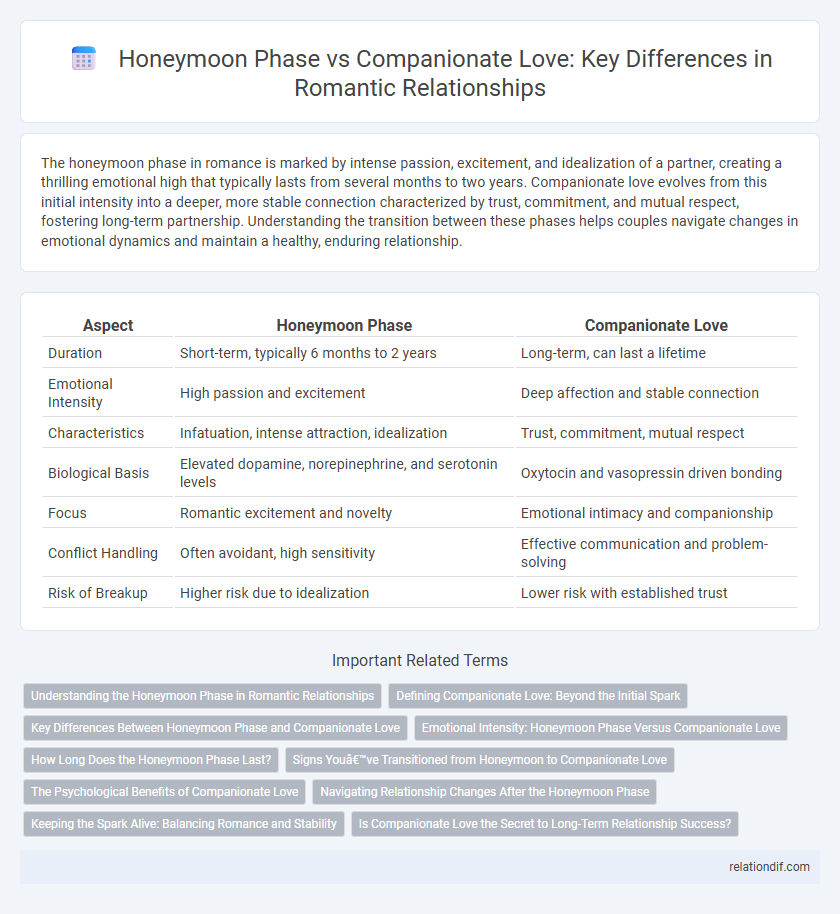The honeymoon phase in romance is marked by intense passion, excitement, and idealization of a partner, creating a thrilling emotional high that typically lasts from several months to two years. Companionate love evolves from this initial intensity into a deeper, more stable connection characterized by trust, commitment, and mutual respect, fostering long-term partnership. Understanding the transition between these phases helps couples navigate changes in emotional dynamics and maintain a healthy, enduring relationship.
Table of Comparison
| Aspect | Honeymoon Phase | Companionate Love |
|---|---|---|
| Duration | Short-term, typically 6 months to 2 years | Long-term, can last a lifetime |
| Emotional Intensity | High passion and excitement | Deep affection and stable connection |
| Characteristics | Infatuation, intense attraction, idealization | Trust, commitment, mutual respect |
| Biological Basis | Elevated dopamine, norepinephrine, and serotonin levels | Oxytocin and vasopressin driven bonding |
| Focus | Romantic excitement and novelty | Emotional intimacy and companionship |
| Conflict Handling | Often avoidant, high sensitivity | Effective communication and problem-solving |
| Risk of Breakup | Higher risk due to idealization | Lower risk with established trust |
Understanding the Honeymoon Phase in Romantic Relationships
The honeymoon phase in romantic relationships typically lasts between six months to two years, characterized by intense passion, idealization, and heightened emotional connection. During this period, partners experience elevated dopamine and oxytocin levels, fueling feelings of euphoria and bonding, which gradually shift toward companionate love marked by deep attachment, trust, and steady affection. Recognizing the transition from the honeymoon phase to companionate love helps couples foster realistic expectations and build long-lasting emotional intimacy.
Defining Companionate Love: Beyond the Initial Spark
Companionate love transcends the initial honeymoon phase by emphasizing deep emotional intimacy, mutual respect, and long-term commitment rather than passionate intensity. This stage is characterized by strong friendship, trust, and shared values that create a stable foundation for enduring relationships. Unlike the fleeting excitement of early romance, companionate love fosters sustained connection and partnership essential for lasting marital satisfaction.
Key Differences Between Honeymoon Phase and Companionate Love
The honeymoon phase is characterized by intense passion, novelty, and idealization of the partner, typically lasting several months to two years, marked by heightened dopamine and serotonin levels. Companionate love evolves over time, emphasizing deep affection, emotional intimacy, and commitment, often associated with oxytocin and endorphin release, fostering stability and trust. Key differences include the initial excitement and infatuation of the honeymoon phase versus the enduring attachment and mutual respect seen in companionate love.
Emotional Intensity: Honeymoon Phase Versus Companionate Love
Emotional intensity in the honeymoon phase is characterized by heightened passion, excitement, and idealization of the partner, often fueled by increased dopamine and oxytocin levels. In contrast, companionate love features a deeper emotional bond marked by stability, trust, and mutual respect, relying more on oxytocin and vasopressin for long-term attachment. While the honeymoon phase emphasizes intense infatuation, companionate love prioritizes enduring connection and emotional support.
How Long Does the Honeymoon Phase Last?
The honeymoon phase typically lasts from six months to two years, characterized by intense passion, excitement, and idealization of a partner. Following this, companionate love develops, marked by deeper emotional connection, stability, and commitment. Research shows that this transition is crucial for building long-term, satisfying relationships grounded in trust and mutual respect.
Signs You’ve Transitioned from Honeymoon to Companionate Love
Signs you've transitioned from the honeymoon phase to companionate love include deeper emotional intimacy, characterized by comfort and trust rather than intense passion. Daily routines and shared responsibilities replace constant excitement, highlighting stability and mutual support as core relationship foundations. Communication shifts from idealized fantasies to realistic conversations about future plans and personal growth together.
The Psychological Benefits of Companionate Love
Companionate love fosters long-term emotional stability by promoting deep trust, mutual respect, and shared values, which contribute to overall well-being and reduced stress levels. Unlike the intense passion of the honeymoon phase, companionate love enhances psychological resilience through consistent support and effective communication. Studies show that couples experiencing companionate love report higher satisfaction and lower anxiety, reinforcing mental health benefits throughout the relationship.
Navigating Relationship Changes After the Honeymoon Phase
Navigating relationship changes after the honeymoon phase involves shifting focus from intense passion to companionate love characterized by deep emotional intimacy, trust, and commitment. Couples who cultivate open communication and mutual support can strengthen their bond, transitioning from idealized romance to a stable, lasting partnership. Understanding this evolution helps partners manage expectations and fosters resilience through life's challenges together.
Keeping the Spark Alive: Balancing Romance and Stability
Keeping the spark alive in a relationship requires balancing the intense passion of the honeymoon phase with the deep emotional connection of companionate love. Couples who nurture ongoing romance through shared experiences, affectionate communication, and spontaneous gestures foster sustained intimacy alongside stability. Prioritizing both excitement and trust strengthens long-term commitment and emotional fulfillment.
Is Companionate Love the Secret to Long-Term Relationship Success?
Companionate love, characterized by deep affection, trust, and mutual respect, often replaces the intense passion of the honeymoon phase to sustain long-term relationship success. Research in psychology highlights that couples experiencing high levels of companionate love report greater relationship satisfaction and stability over time. Prioritizing emotional intimacy and shared life goals forms the foundation that transforms transient honeymoon excitement into enduring partnership resilience.
honeymoon phase vs companionate love Infographic

 relationdif.com
relationdif.com